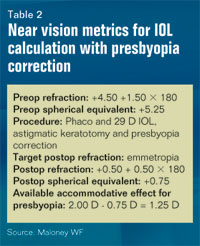Presbyopia correction must start at emmetropia
The accuracy of IOL calculation is redefined by presbyopia correction.
Click Here to Manage Email Alerts
All successful efforts to correct presbyopia begin at the same precise point: emmetropia. Regardless of the underlying distance refractive error or the presbyopic IOL to be used, we must first get to this refractive goal. Exact emmetropia at distance — our zero starting point — is the foundation upon which the additional accommodative effect is “added.”
The optical formula for IOL presbyopia correction is a familiar one. It is no different than the formula for a successful spectacle presbyopia correction — emmetropia plus the reading “add.” Unfortunately, achieving emmetropia with an IOL to this degree of precision is hardly the routine matter it is with spectacles.
Although we increasingly hear from those presenting their data on presbyopia lens implants that “accurate IOL calculations are important,” these broad generalizations mask the depth of the challenge that presbyopia surgeons face.
If we are serious about consistently successful lens implant presbyopia correction, a major recalibration of the metrics used in IOL calculation will be necessary. Here are the sobering details that you certainly will not hear from the typical podium infomercial promoting a presbyopic IOL.
IOL accuracy redefined
![OSN Lens-Based Refractive Surgery [logo]](/images/commonart/refractive.gif)
We have been remarkably successful in our accuracy to correct distance vision with IOLs. Incremental improvements in calculation methods over the past 20 years have brought us to where we can now consistently provide uncorrected distance vision in almost all cases. In fact, an IOL approach is now the most accurate means of correcting a large refractive error in both cataract and refractive candidates.
|
|
As an example, I think we all would agree that if our IOL calculation resulted in a correction from –12.5 D of myopia or +4.5 D of hyperopia to a +0.5 D result, we could expect a highly satisfied patient and congratulate our technicians on a successful IOL calculation. Successful for distance, yes, but if this patient is also having presbyopia corrected with this IOL procedure, we may suddenly be facing a failure.
When we introduce reading correction to the expected outcome, this +0.5 D of uncorrected residual hyperopic defocus will directly reduce our available reading add by a significant amount. (Conversely, a result of 0.5 D of myopic defocus would increase the reading add correspondingly. Thus, a purposeful targeting of some degree of myopic defocus – usually in one eye — is widely used in presbyopia correction, but this “enhanced add” must still be calculated from the emmetropic zero target.)
Today’s presbyopic IOL typically delivers around 2 D of accommodative effect. Against this metric, a hyperopic calculation result of just 0.5 D is potentially a significant error of 25%. The +2 D of reading add available from our chosen presbyopic IOL is now suddenly reduced to +1.5 D.
This weaker reading add will not be sufficient to meet many patient’s reading needs, especially if they have selected full zone 1 reading as a goal of the procedure.
Sobering statistics
The degree of IOL calculation accuracy required for successful presbyopia correction is ±0.25 D. This is true no matter the IOL used. It is also true no matter how extreme the distance refractive error. A 15 D myope or an 8 D hyperope must both be brought to within ±0.25 D of the zero starting point: emmetropia. The subsequent presbyopia correction in each case will depend on full use of the same approximately 2 D add available in the chosen IOL.
If you have not yet started presbyopia correction, you may be asking, “Is that really possible?” Yes (we plan to outline the details in future columns), but it is not possible with the usual applanation A-scan measurement technique employed by the majority of surgeons.
If this degree of accuracy sounds excessive, then you are still using distance metrics to evaluate near correction. The difference is crucial. Let’s first use distance vision metrics and look at an IOL calculation and refractive result for a hyperopic cataract patient without presbyopia correction (Table 1).
By any standard, this would be considered a very good refractive result for distance correction and should result in a satisfied patient. Although exact emmetropia was not achieved, the margin of error is acceptable, especially considering the degree of preop hyperopia.
Now let’s look at the same outcome for the same patient using the near vision metrics necessary for cataract surgery with presbyopia correction (Table 2).
This 0.75 D of hyperopia comes right off the bottom line of our potential 2 D presbyopia correction. In fact, what had been a relatively insignificant error for purposes of distance correction becomes an error of 37% for subsequent presbyopia treatment.
Astigmatic keratotomy essential
Astigmatism of 1 D or more suddenly becomes highly significant in the more demanding metrics of presbyopia correction. The effect of this same 0.75 hyperopic defocus — this time from uncorrected corneal astigmatism — has the same negative impact of significantly reducing the available accommodative effect for presbyopia correction (Table 3).
The message is clear. If we intend to treat presbyopia, we cannot succeed without devoting significant recourses to recalibrating our IOL calculations and astigmatic techniques using much more demanding metrics. The fact is that the excellent refractive results that we have come to achieve for distance correction are suddenly no longer good enough when presbyopia correction is added to the equation. Welcome to the challenging world of presbyopia correction. The results are worth the effort.
For Your Information:
- William F. Maloney, MD, is head of Eye Surgery Associates of Vista, Calif., and a well-known teacher of cataract and lens-based refractive surgery techniques. He can be reached at 2023 West Vista Way, Suite A, Vista, CA 92083; 760-941-1400; fax: 760-941-9643; e-mail: maloneyeye@yahoo.com. In the interest of objectivity, Dr. Maloney has no financial interest in any ophthalmic product and has no financial relationship with any ophthalmic company.



